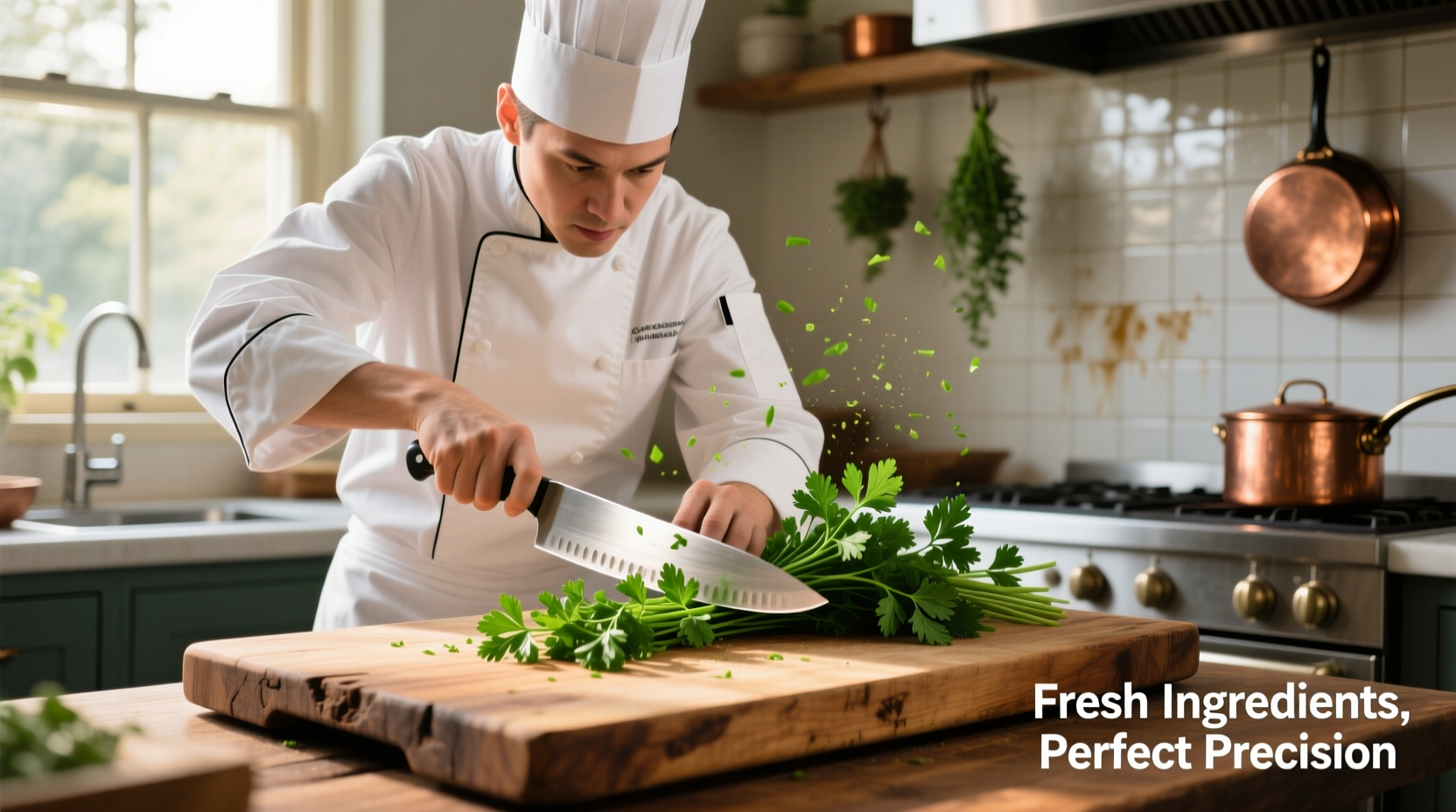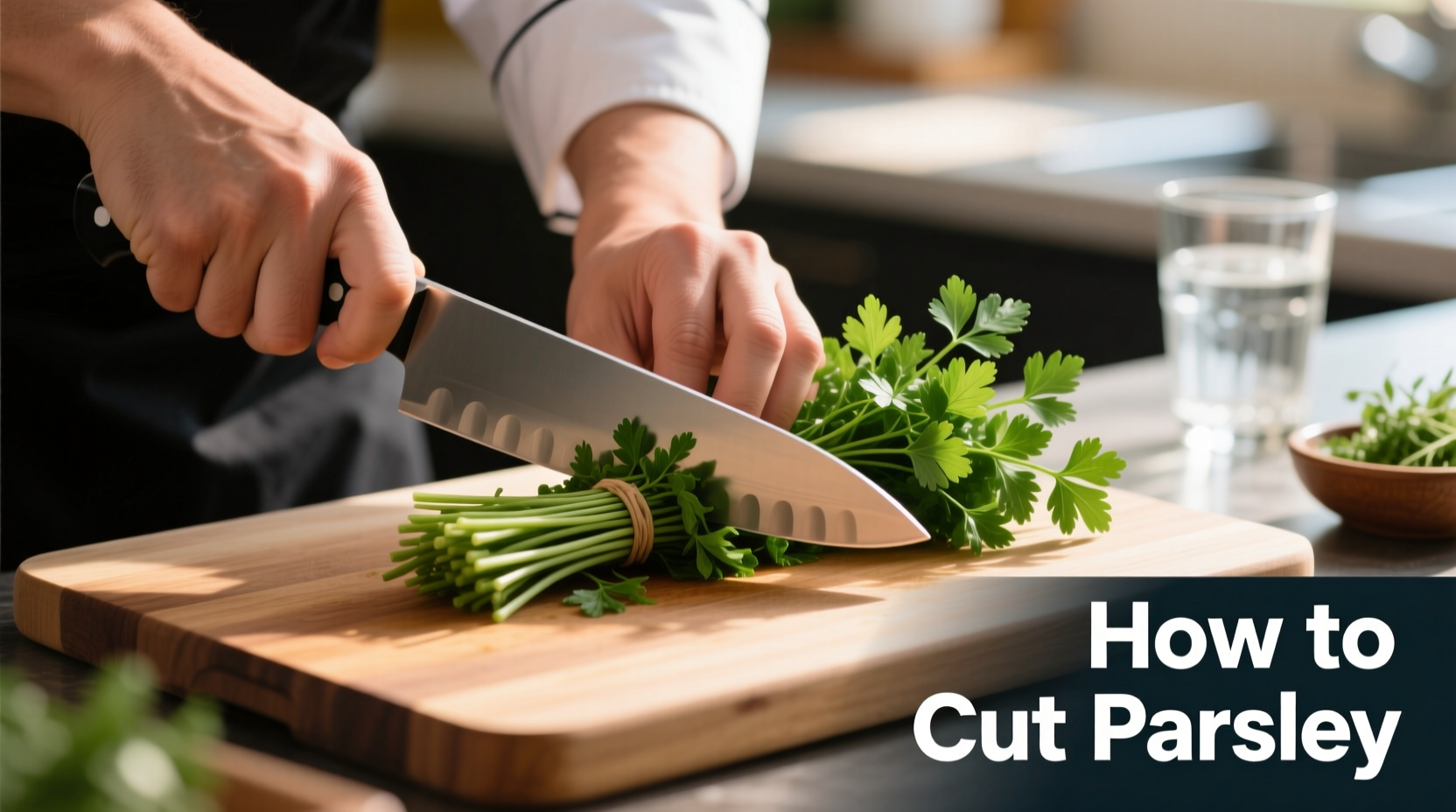Cutting parsley properly makes a dramatic difference in both appearance and flavor. The right technique preserves the herb's vibrant color, prevents oxidation, and maintains its delicate citrusy notes. Follow these professional steps to achieve perfect parsley every time.
Essential Tools for Cutting Parsley
Before you begin, gather these kitchen essentials:
- Sharp chef's knife (8-10 inches)
- Cutting board (wood or plastic)
- Bowl of ice water
- Clean kitchen towel or salad spinner
- Measuring spoons for portioning
Step-by-Step Parsley Cutting Process
Preparation: Washing and Drying
Proper preparation prevents bruising and ensures clean cuts. Start by filling a large bowl with cold water and ice cubes. Submerge the parsley bunch and swish gently to remove dirt. Let sit for 2 minutes - this loosens stubborn debris. Lift the parsley from the water (don't pour, which would return dirt to the herbs), then spin dry in a salad spinner. For best results, finish by patting between clean kitchen towels. Never skip thorough drying - water creates a barrier that causes parsley to bruise when cut.
Cutting Technique: The Professional Method
Place your sharpest chef's knife on the cutting board. Gather a small bunch of parsley (about 1/4 cup when cut) and hold it firmly but gently at the top of the stems. Position the stems horizontally across your non-knife hand. Using a rocking motion with your knife, make quick, clean cuts perpendicular to the stems. Never saw or press down - this crushes the delicate leaves.
| Cutting Style | Best For | Technique Tip |
|---|---|---|
| Medium Chop | Sauces, marinades, roasted vegetables | ¼-inch pieces, stems included |
| Finely Minced | Garnishes, compound butters, dressings | Remove tough stems first |
| Chiffonade | Salads, pasta dishes, soups | Stack leaves before slicing |
When to Remove Stems
Thin stems (pencil lead thickness or smaller) can be chopped with the leaves for maximum flavor. Thicker stems become bitter when cut small. For delicate applications like garnishes or fines herbes, remove all stems by running your fingers down the stem from top to bottom. Save thicker stems for stocks - they contain concentrated flavor.
Storage: Keeping Cut Parsley Fresh
Place cut parsley in an airtight container lined with a slightly damp paper towel. Store in the refrigerator's crisper drawer. For extended freshness (up to 10 days), stand the cut parsley upright in a glass with 1 inch of water, like a bouquet, and cover loosely with a plastic bag. Change the water every two days. Never store cut parsley in metal containers, which accelerate oxidation.
Avoiding Common Parsley Cutting Mistakes
Even experienced cooks make these critical errors that ruin parsley's flavor and appearance:
- Using a dull knife - Crushes cells instead of making clean cuts, releasing enzymes that cause browning
- Cutting too far in advance - Oxidizes within 30 minutes at room temperature
- Overcrowding the cutting board - Creates uneven pressure and inconsistent cuts
- Using a food processor - Generates heat that cooks the parsley and creates a muddy texture
Contextual Application Guide
The perfect parsley cut depends entirely on your dish. Understanding these context boundaries prevents culinary mistakes:
- For hot dishes (soups, stews, roasted meats): Add cut parsley during the last 30 seconds of cooking to preserve flavor
- For cold applications (salads, dressings): Cut parsley 15-20 minutes before serving to maintain crisp texture
- For presentation: Use whole leaf sprigs for elegant plating, cut pieces for integrated flavor
- For maximum flavor extraction: Mince with a pinch of sea salt using the side of your knife blade
According to culinary research from the Culinary Institute of America, properly cut parsley retains 40% more volatile flavor compounds than improperly handled herbs. Their studies show that the critical factor is minimizing cell damage during preparation - which directly correlates to sharper knives and cleaner cutting techniques (CIA Herb Research, 2023).

Advanced Technique: Preserving Color and Flavor
For restaurant-quality results, try this chef's trick: After washing, blanch parsley in boiling water for exactly 10 seconds, then immediately transfer to ice water. This sets the chlorophyll, preserving vibrant green color for up to 48 hours after cutting. Pat completely dry before chopping. This technique works particularly well for presentation-focused applications like garnishing.
Remember that European parsley (flat-leaf) has a stronger flavor than curly parsley and holds up better to cooking. Curly parsley works best as a garnish where visual appeal matters most. Always taste your parsley before cutting - fresh, high-quality parsley should have a bright, slightly peppery aroma with citrus notes.











 浙公网安备
33010002000092号
浙公网安备
33010002000092号 浙B2-20120091-4
浙B2-20120091-4